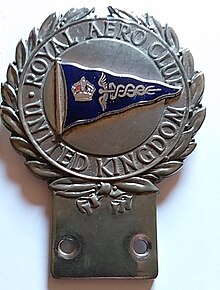
The Royal Aero Club (RAeC) is the national co-ordinating body for air sport in the United Kingdom. It was founded in 1901 as the Aero Club of Great Britain, being granted the title of the "Royal Aero Club" in 1910.[ citation needed ]

The Royal Aero Club (RAeC) is the national co-ordinating body for air sport in the United Kingdom. It was founded in 1901 as the Aero Club of Great Britain, being granted the title of the "Royal Aero Club" in 1910.[ citation needed ]
The Aero Club was founded in 1901 by Frank Hedges Butler, his daughter Vera and the Hon Charles Rolls (one of the founders of Rolls-Royce), partly inspired by the Aero Club of France. It was initially concerned more with ballooning but after the demonstrations of heavier-than-air flight made by the Wright Brothers in France in 1908, it embraced the aeroplane. The original club constitution declared that it was dedicated to 'the encouragement of aero auto-mobilism and ballooning as a sport.' As founded, it was primarily a London gentlemen's club, but gradually moved on to a more regulatory role. It had a clubhouse at 119 Piccadilly, which it retained until 1961. [1]
The club was granted its Royal prefix on 15 February 1910. [2] From 1910 the club issued Aviators Certificates, which were internationally recognised under the Fédération Aéronautique Internationale (the FAI) to which the club was the UK representative. The club is the governing body in the UK for air sports, as well as for records and competitions.

The club established its first flying ground on a stretch of marshland at Shellbeach near Leysdown on the Isle of Sheppey in early 1909. A nearby farmhouse, Mussell Manor (now called Muswell Manor) became the flying ground clubhouse, and club members could construct their own sheds to accommodate their aircraft. Among the first occupants of the ground were Short Brothers. Two of the brothers, Eustace and Oswald, had previously made balloons for Aero Club members and been appointed the official engineers of the Aero Club. They had also enlisted their eldest brother, Horace, when they decided to begin constructing heavier-than-air aircraft. They acquired a licence to build copies of the Wright aircraft and set up the first aircraft production line in the world at Leysdown.
On 1 May 1909 John Moore-Brabazon (later Lord Brabazon of Tara) made a flight of 500 yards in his Voisin at Shellbeach. [3] This is officially recognised as the first flight by a British pilot in Britain.
The same week the Wright brothers visited the Aero Club flying ground at Shellbeach. After inspecting the Short Brothers' factory, a photograph was taken outside Mussell Manor of the Wright Brothers with all of the early British aviation pioneers to commemorate their visit to Britain. [4]
In October 1909, the club recognised the Blackpool Aviation Week, making it Britain's first official air show. On 30 October Moore-Brabazon was also the first to cover a mile (closed circuit) in a British aeroplane, flying the Short Biplane No. 2, and so winning a prize of £1,000 offered by the Daily Mail newspaper. [5] On 4 November 1909, he decided to take up a piglet, which he named Icarus the Second, as a passenger, thereby disproving the adage that "pigs can't fly".
It moved the next year to nearby Eastchurch, where the Royal Navy had established a flying school.[ citation needed ]
Until 1911 the British Military did not have any pilot training facilities. As a result, most early military pilots were trained by members of the club and many became members. By the end of the First World War, more than 6,300 military pilots had taken RAeC Aviator's Certificates.[ citation needed ]
After the loss of its Piccadilly clubhouse in 1961, the club was lodged at the Lansdowne Club at 9 Fitzmaurice Place until 1968. It then moved for a short spell to the Junior Carlton Club's modern building at 94 Pall Mall. In June 1973 the club merged with the United Service Club and moved into its premises at 116 Pall Mall. All its aviation-related activities were then transferred to the Aviation Council (United Service and Royal Aero Club) Ltd incorporated on 15 February 1973. In June 1975, the United Service and Royal Aero Club merged with the Naval and Military Club and on 1 August 1975 the Royal Aero Club of the United Kingdom was officially launched and endowed with all its awards, library and memorabilia and took the place of the Aviation Council. By 1977, the club had ceased to be a members club but continued to carry out the function previously carried out by its Aviation Council, with the Secretariat based at the Leicester premises of the British Gliding Association. [1]
Today the Royal Aero Club continues to be the national governing and coordinating body of air sport and recreational flying. The governing bodies of the various forms of sporting aviation (for example British Aerobatic Association) are all members of the Royal Aero Club, which is the UK governing body for international sporting purposes. The Royal Aero Club also acts to support and protect the rights of recreational pilots in the context of national and international regulation.
The following were the first ten people to gain their aviator certificates from the Royal Aero Club: [6] [7]
The first women to be awarded their aviator certificates from the Royal Aero Club were Hilda Hewlett on 29 August 1911(certificate No.122) followed by Cheridah de Beauvoir Stocks (certificate No. 153) on 7 November 1911. [8]
A number of air races were organised by the club:
The Britannia Trophy is presented by the Royal Aero Club for aviators accomplishing the most meritorious performance in aviation during the previous year.
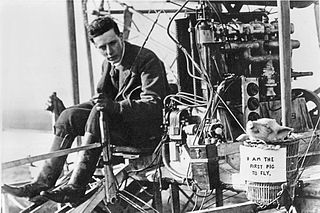
This is a list of aviation-related events from 1909:
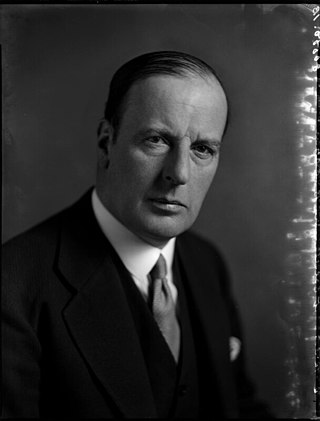
Lieutenant Colonel John Theodore Cuthbert Moore-Brabazon, 1st Baron Brabazon of Tara,, HonFRPS was an English aviation pioneer and Conservative politician. He was the first Englishman to pilot a heavier-than-air machine under power in England, and he served as Minister of Transport and Minister of Aircraft Production during the Second World War.

Eastchurch is a village and civil parish on the Isle of Sheppey, in the English county of Kent, two miles east of Minster. The village website claims the area has "a history steeped in stories of piracy and smugglers".
Pilot licensing or certification refers to permits for operating aircraft. Flight crew licences are issued by the civil aviation authority of each country, which must establish that the holder has met minimum knowledge and experience before issuing licences. The licence, along with the required class or type rating, allows a pilot to fly aircraft registered in the licence issuing state.

The Aero Club of America was a social club formed in 1905 by Charles Jasper Glidden and Augustus Post, among others, to promote aviation in America. It was the parent organization of numerous state chapters, the first being the Aero Club of New England. It thrived until 1923, when it transformed into the National Aeronautic Association, which still exists today. It issued the first pilot's licenses in the United States, and successful completion of its licensing process was required by the United States Army for its pilots until 1914. It sponsored numerous air shows and contests. Cortlandt Field Bishop was president in 1910. Starting in 1911, new president Robert J. Collier began presenting the Collier Trophy.
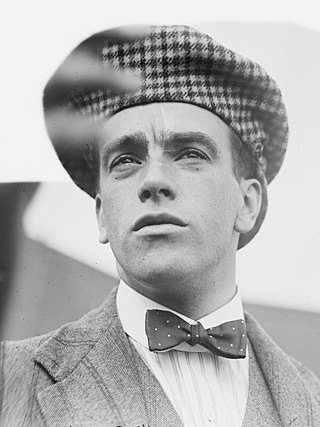
Claude Grahame-White was an English pioneer of aviation, and the first to make a night flight, during the Daily Mail-sponsored 1910 London to Manchester air race.

Isidore Auguste Marie Louis Paulhan, was a French aviator. He is known for winning the first Daily Mail aviation prize for the first flight between London and Manchester in 1910.
Arthur Edward George was an accomplished sportsman, an aviation pioneer, aircraft designer, racing driver, engineer and businessman. He served in the Second Boer War, in World War I and in World War II, and was awarded the Silver medal of the Royal Aero Club posthumously for his "Services to aviation over 50 years".

The Dunne D.5 was a British experimental aircraft built in 1910. A tailless swept-wing biplane, it was designed by J. W. Dunne and built by Short Brothers at Leysdown for his company, the Blair Atholl Aeroplane Syndicate Ltd. Like its military predecessors it was driven by twin pusher propellers, but it had a considerably more powerful engine.
Royal Air Force Eastchurch or more simply RAF Eastchurch is a former Royal Air Force station near Eastchurch village, on the Isle of Sheppey, Kent, England. The history of aviation at Eastchurch stretches back to the first decade of the 20th century when it was used as an airfield by members of the Royal Aero Club. The area saw the first flight by a British pilot in Britain.
Captain Horatio Claude Barber (1875–1964) was an early British aviation pioneer and First World War flight instructor. In 1911 he flew the first cargo flight in Britain, transporting electric light bulbs from Shoreham to Hove. He was also the first person in Great Britain to gain an aeronautical degree.
Flight Lieutenant Cyril Burfield Ridley was a British World War I flying ace, who served in the Royal Naval Air Service and the Royal Air Force, before being killed in a flying accident in 1920.
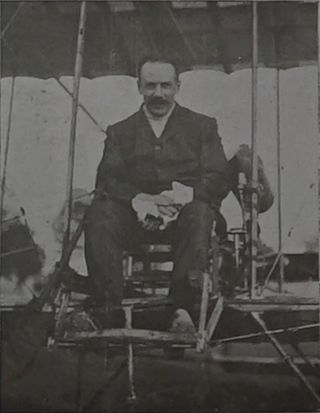
George Bertram Cockburn OBE was a research chemist who became an aviation pioneer. He represented Great Britain in the first international air race at Rheims and co-founded the first aerodrome for the army at Larkhill. He also trained the first four pilots of what was to become the Fleet Air Arm. During World War I he worked as a Government Inspector of Aeroplanes for the Royal Flying Corps at Farnborough and subsequently became Head of the Accidents Branch of the Department of the Controller-General of Civil Aviation at the Air Ministry.
Cecil Stanley Grace was a pioneer aviator who went missing on a flight across the English Channel in 1910.

For the businessman, see Alec Ogilvie (businessman).

The Short S.27 and its derivative, the Short Improved S.27, were a series of early British aircraft built by Short Brothers. They were used by the Admiralty and Naval Wing of the Royal Flying Corps for training the Royal Navy's first pilots as well as for early naval aviation experiments. An Improved S.27 was used by C.R. Samson to make the first successful take-off from a moving ship on 9 May 1912.
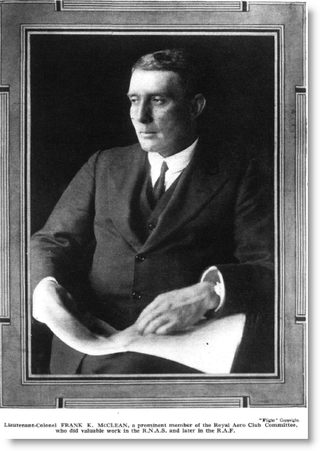
Lieutenant-Colonel Sir Francis Kennedy McClean, was a British civil engineer and pioneer aviator.

The Cody Michelin Cup Biplane was an experimental aircraft designed and built in Britain during 1910 by Samuel Franklin Cody, a prominent showman and aviation pioneer. Cody had worked with the British Army on experiments with man-lifting kites and in October 1908 had successfully built and flown the British Army Aeroplane No 1, making the first officially verified powered flight in the United Kingdom. Cody broke the existing endurance record twice in the aircraft, the second flight, made on 31 December 1910, winning him the Michelin Cup for the longest-lasting flight made over a closed circuit in the United Kingdom before the end of the year.

The Memorial to the Home of Aviation is a stone memorial sculpture at Eastchurch, on the Isle of Sheppey in the English county of Kent. The Grade II* listed memorial, unveiled in 1955, commemorates the early aviation flights from Leysdown and Eastchurch by members of the club that became the Royal Aero Club of Great Britain in 1910, and the air base established by the Royal Navy near Eastchurch in 1911.